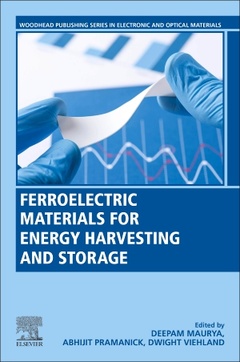Ferroelectric Materials for Energy Harvesting and Storage Woodhead Publishing Series in Electronic and Optical Materials Series
Coordonnateurs : Maurya Deepam, Pramanick Abhijit, Viehland Dwight

2. Solar energy harvesting with ferroelectric materials
3. Harvesting thermal energy with ferroelectric materials
4. Leveraging size effects in flexoelectric-piezoelectric vibration energy harvesting
5. Modeling and identification of nonlinear piezoelectric material properties for energy harvesting
6. Wind energy harvesting using piezoelectric materials
7. Biomechanical energy harvesting with piezoelectric materials
8. Harvesting stray magnetic field for powering wireless sensors
9. Lead-based and lead-free ferroelectric ceramic capacitors for electrical energy storage
Abhijit Pramanick is an Assistant Professor at the City University of Hong Kong. He obtained his Bachelors in Engineering from the National Institute of Technology, Rourkela, India and his Masters in Engineering from the Indian Institute of Science, Bangalore. He was awarded PhD in Materials Science and Engineering in 2009 from the University of Florida, Gainesville. After his PhD, he spent one year as a postdoctoral researcher at the ceramics laboratory of the Alfred University in New York, USA. Subsequently, he moved to the Oak Ridge National Laboratory, where he spent three and half years working on the applications of different neutron scattering techniques to understand the microscopic origins of functional responses in ferroelectric and ferromagnetic materials. He has co-authored over 30 publications. For his work on ferroelectric ceramics, he was awarded the prestigious Edward C. Henry Award by the American Ceramic Society in the years 2010 and 2012. His current research interests include understanding composition-structure-property correlations in ferroelectric ceramic and polymeric materials that are used in smart technologies and energy applications using advanced neutron and
- Reviews wide range of energy harvesting including solar, wind, biomechanical and more
- Discusses ferroelectric materials and their application to high energy density capacitors
- Includes review of fundamental mechanisms of energy harvesting and energy solutions, their design and current applications, and future trends and challenges
Date de parution : 10-2020
Ouvrage de 372 p.
15x22.8 cm
Thèmes de Ferroelectric Materials for Energy Harvesting and Storage :
Mots-clés :
00-01; 2010 MSC; 99-00; Aeroelastic instabilities; Biomechanical; Bulk photovoltaic effect; Capacitor; Ceramic; Composite; Crystallographic anisotropy; Dielectric; Domain switching; Electromechanical coupling; Energy harvesters; Energy harvesting; Energy harvesting devices; Energy storage; Ferroelectric; Ferroelectrics; Flexoelectricity; Flexoelectrics; Flutter; Galloping; Lead-based; Lead-free; Limit-cycle oscillation; Magneto-mechano-electric generator; Magnetostrictive; MEMS; Micro-electromechanical system; Multiferroic; Nanogenerator; NEMS; Nonlinear phenomena; Perovskites; Photoelectrochemical water splitting; Photovoltaic effect; piezoelectric; Piezoelectric; Piezoelectric effects; Piezoelectric element; Piezoelectricity; Piezoelectrics; PLZT; Polarization; Pyroelectric; Pyroelectrics; PZT; Saturation; Sensors; Shift current model; Single crystals; Strain gradient; Super-harmonics; Thermal energy; Vortex-induced vibration; Wireless sensor networks



